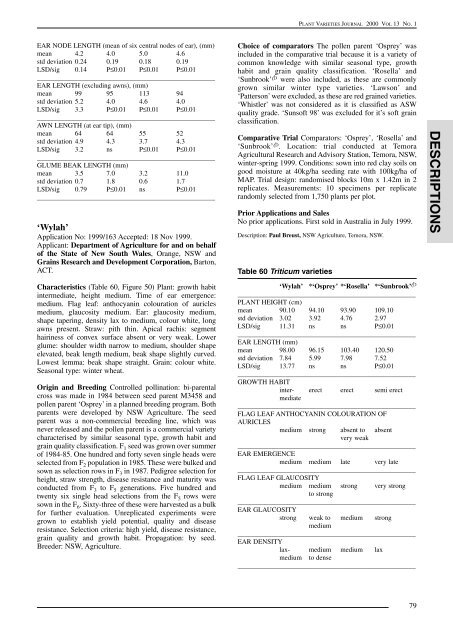53. Volume 13- Number 1 - IP Australia
53. Volume 13- Number 1 - IP Australia
53. Volume 13- Number 1 - IP Australia
Create successful ePaper yourself
Turn your PDF publications into a flip-book with our unique Google optimized e-Paper software.
DESCR<strong>IP</strong>TIONS<br />
PLANT VARIETIES JOURNAL 2000 VOL <strong>13</strong> NO. 1<br />
EAR NODE LENGTH (mean of six central nodes of ear), (mm)<br />
mean 4.2 4.0 5.0 4.6<br />
std deviation 0.24 0.19 0.18 0.19<br />
LSD/sig 0.14 P≤0.01 P≤0.01 P≤0.01<br />
____________________________________________________<br />
EAR LENGTH (excluding awns), (mm)<br />
mean 99 95 1<strong>13</strong> 94<br />
std deviation 5.2 4.0 4.6 4.0<br />
LSD/sig 3.3 P≤0.01 P≤0.01 P≤0.01<br />
____________________________________________________<br />
AWN LENGTH (at ear tip), (mm)<br />
mean 64 64 55 52<br />
std deviation 4.9 4.3 3.7 4.3<br />
LSD/sig 3.2 ns P≤0.01 P≤0.01<br />
____________________________________________________<br />
GLUME BEAK LENGTH (mm)<br />
mean 3.5 7.0 3.2 11.0<br />
std deviation 0.7 1.8 0.6 1.7<br />
LSD/sig 0.79 P≤0.01 ns P≤0.01<br />
____________________________________________________<br />
Choice of comparators The pollen parent ‘Osprey’ was<br />
included in the comparative trial because it is a variety of<br />
common knowledge with similar seasonal type, growth<br />
habit and grain quality classification. ‘Rosella’ and<br />
‘Sunbrook’ A were also included, as these are commonly<br />
grown similar winter type varieties. ‘Lawson’ and<br />
‘Patterson’ were excluded, as these are red grained varieties.<br />
‘Whistler’ was not considered as it is classified as ASW<br />
quality grade. ‘Sunsoft 98’ was excluded for it’s soft grain<br />
classification.<br />
Comparative Trial Comparators: ‘Osprey’, ‘Rosella’ and<br />
‘Sunbrook’ A . Location: trial conducted at Temora<br />
Agricultural Research and Advisory Station, Temora, NSW,<br />
winter-spring 1999. Conditions: sown into red clay soils on<br />
good moisture at 40kg/ha seeding rate with 100kg/ha of<br />
MAP. Trial design: randomised blocks 10m x 1.42m in 2<br />
replicates. Measurements: 10 specimens per replicate<br />
randomly selected from 1,750 plants per plot.<br />
‘Wylah’<br />
Application No: 1999/163 Accepted: 18 Nov 1999.<br />
Applicant: Department of Agriculture for and on behalf<br />
of the State of New South Wales, Orange, NSW and<br />
Grains Research and Development Corporation, Barton,<br />
ACT.<br />
Characteristics (Table 60, Figure 50) Plant: growth habit<br />
intermediate, height medium. Time of ear emergence:<br />
medium. Flag leaf: anthocyanin colouration of auricles<br />
medium, glaucosity medium. Ear: glaucosity medium,<br />
shape tapering, density lax to medium, colour white, long<br />
awns present. Straw: pith thin. Apical rachis: segment<br />
hairiness of convex surface absent or very weak. Lower<br />
glume: shoulder width narrow to medium, shoulder shape<br />
elevated, beak length medium, beak shape slightly curved.<br />
Lowest lemma: beak shape straight. Grain: colour white.<br />
Seasonal type: winter wheat.<br />
Origin and Breeding Controlled pollination: bi-parental<br />
cross was made in 1984 between seed parent M3458 and<br />
pollen parent ‘Osprey’ in a planned breeding program. Both<br />
parents were developed by NSW Agriculture. The seed<br />
parent was a non-commercial breeding line, which was<br />
never released and the pollen parent is a commercial variety<br />
characterised by similar seasonal type, growth habit and<br />
grain quality classification. F 1 seed was grown over summer<br />
of 1984-85. One hundred and forty seven single heads were<br />
selected from F 2 population in 1985. These were bulked and<br />
sown as selection rows in F 3 in 1987. Pedigree selection for<br />
height, straw strength, disease resistance and maturity was<br />
conducted from F 3 to F 5 generations. Five hundred and<br />
twenty six single head selections from the F 5 rows were<br />
sown in the F 6 . Sixty-three of these were harvested as a bulk<br />
for further evaluation. Unreplicated experiments were<br />
grown to establish yield potential, quality and disease<br />
resistance. Selection criteria: high yield, disease resistance,<br />
grain quality and growth habit. Propagation: by seed.<br />
Breeder: NSW, Agriculture.<br />
Prior Applications and Sales<br />
No prior applications. First sold in <strong>Australia</strong> in July 1999.<br />
Description: Paul Breust, NSW Agriculture, Temora, NSW.<br />
Table 60 Triticum varieties<br />
‘Wylah’ *‘Osprey’ *‘Rosella’ *‘Sunbrook’ A<br />
____________________________________________________<br />
PLANT HEIGHT (cm)<br />
mean 90.10 94.10 93.90 109.10<br />
std deviation 3.02 3.92 4.76 2.97<br />
LSD/sig 11.31 ns ns P≤0.01<br />
____________________________________________________<br />
EAR LENGTH (mm)<br />
mean 98.00 96.15 103.40 120.50<br />
std deviation 7.84 5.99 7.98 7.52<br />
LSD/sig <strong>13</strong>.77 ns ns P≤0.01<br />
____________________________________________________<br />
GROWTH HABIT<br />
inter- erect erect semi erect<br />
mediate<br />
____________________________________________________<br />
FLAG LEAF ANTHOCYANIN COLOURATION OF<br />
AURICLES<br />
medium strong absent to absent<br />
very weak<br />
____________________________________________________<br />
EAR EMERGENCE<br />
medium medium late very late<br />
____________________________________________________<br />
FLAG LEAF GLAUCOSITY<br />
medium medium strong very strong<br />
to strong<br />
____________________________________________________<br />
EAR GLAUCOSITY<br />
strong weak to medium strong<br />
medium<br />
____________________________________________________<br />
EAR DENSITY<br />
lax- medium medium lax<br />
medium to dense<br />
____________________________________________________<br />
79

















